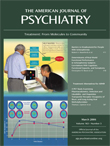Munchausen’s Syndrome With 20-Year Follow-Up
To the Editor:
We report a 20-year follow-up for a patient with Munchausen’s syndrome simulating torsion dystonia that was first presented in 1985 (1). Long-term follow-up for patients with Munchausen’s syndrome is rare because of the secretive nature of the disease and the limitations in sharing confidential patient information.
Ms. A is now a 56-year-old woman who had worked as a teacher until she reportedly suffered a traumatic brain injury when she was pushed by a student. Neuroimaging after the incident was unremarkable, and a neurological examination revealed only bilateral ankle inversion consistent with her history of torsion dystonia. Two weeks later, she was found severely dehydrated and unable to walk or dial for help because of an apparent exacerbation of her torsion dystonia. Her symptoms progressed upon hospitalization. She developed severe language deficits, including the inability to read or write. When transferred to a rehabilitation facility, she reported auditory hallucinations and paranoid delusions and fled the facility several times. During psychiatric consultation, she described a recent suicide attempt by drug overdose but reported no history of psychiatric conditions or hospitalizations.
Upon admission to a psychiatry unit, Ms. A’s psychotic symptoms and suicidal ideation immediately resolved. A search of medical records revealed that she had been described in a case report 20 years earlier. At the age of 19, she feigned suicide to gain admission for psychiatric care. In 1979 she submitted to bilateral ventrolateral thalamotomy for an intractable dystonia that lacked typical electromyographic findings. She had a devastating subsequent course of aphonia lasting 18 months, intractable seizures leading to tracheostomy, trismus requiring a gastrostomy tube, and severe weight loss that was thought secondary to surreptitiously discarding her gastrostomy tube feedings. With psychotherapy she eventually admitted to fabricating all of her symptoms.
Ms. A later moved to our city and taught for nearly 20 years. In 1990 she had two hospital admissions for Behçet’s disease, a diffuse vasculitis often associated with uveitis and aphthous ulcers. There were no objective findings, and she was discharged with probable factitious disorder. She has otherwise led a productive life, free of hospital admissions, for the last 15 years.
Patients with factitious disorder can suffer considerable iatrogenic morbidity and place immense strain on the health care system. Health care providers may develop a sense of therapeutic nihilism. Factitious disorders are often refractory to psychotherapy, and confronting patients about their symptoms is rarely beneficial (2). With psychotherapy this once severely disabled woman achieved relative independence for many years. Whether she sustained a traumatic brain injury before her most recent admission is questionable, but the acute stress of an assault at work may have caused an exacerbation of this patient’s factitious disorder.
1. Batshaw ML, Wachtel RC, Deckel AW, Whitehouse PJ, Moses HIII, Fochtman LJ, Eldridge R: Munchausen’s syndrome simulating torsion dystonia. N Engl J Med 1985; 312:1437–1439Crossref, Medline, Google Scholar
2. Krahn LE, Li H, O’Connor MK: Patients who strive to be ill: factitious disorder with physical symptoms. Am J Psychiatry 2003; 160:1163–1168Link, Google Scholar



